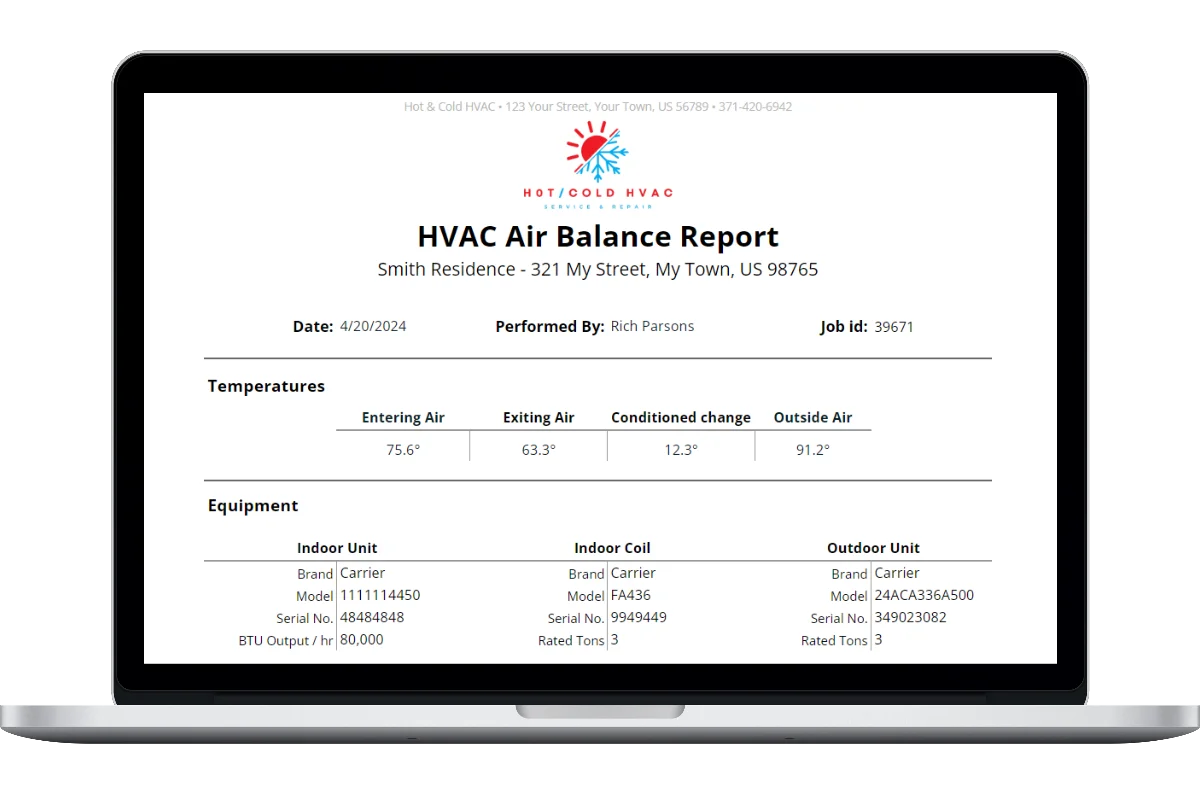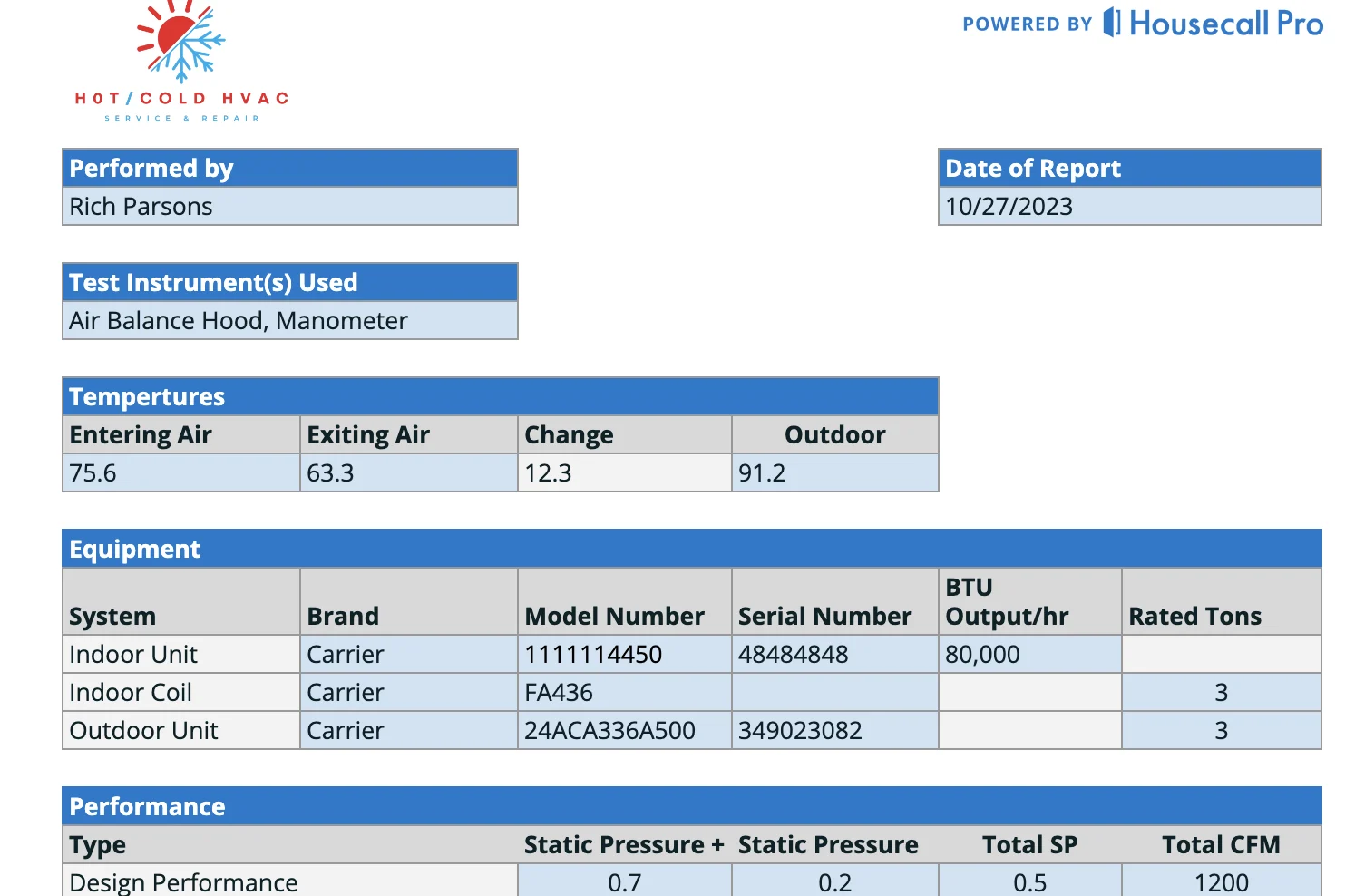
The best checklists create the best results
Free and easy to use HVAC air balance template from Housecall Pro
Stay on top of your air balancing with our simple-to-use HVAC air balance template. Get proactive and streamline your operations.

Here’s everything included in our air balance template
Recording the right air balance test results is a top priority for any HVAC company. Having a simple, straightforward air balance report template makes that a whole lot easier. Our HVAC air balance template contains:
-
Step by step instructions to create and save your own reports
-
Record all the info you need for service and for customers
-
Printable report for your records or to send to customers
-
Customizable to your needs and client’s building
Get In Touch: 858-251-9751
Download our HVAC air balance report template
FAQ
-
What is an HVAC air balance report template?
-
HVAC air balance reports are used to document and record HVAC equipment air balancing test results. The report is sometimes called a testing, adjusting, and balancing (TAB) report as well. It’s often required in new construction projects before occupancy to make sure HVAC systems operate with maximum energy efficiency.
To make sure you have everything covered that needs documentation, you can use a simple HVAC air balance report template (like this one). An HVAC air balance report template will help keep your team on the same page with one standardized report.
-
What is the purpose of the HVAC air balance template?
-
An air balance report updates your team on a system’s status, measured performance, or any metric you choose. It walks you through everything you need to be sure your customers receive quality airflow in their homes. We created this fully customizable template to save you time, instead of having your team recreate the same document over and over again.
-
What does an HVAC air balance report include?
-
An air balance report walks you through the steps to evaluate a forced-air system to make sure everything is running smoothly. Here’s what an HVAC air balance report should include:
- Project information: Customer address, calibration date, and testing instruments
- Equipment information: Manufacturer, model number, serial numbers, and technical design data specifications
- HVAC system and components: Air handling unit (AHU), filters, coils, and the terminal unit, also called Variable Air Volume (VAV) or Constant Air Volume (CAV) boxes
- Airspeed volume: Measured by cubic feet per minute (CFM) through ductwork at grilles, registers, and diffusers using a Pitot tube traverse and other instruments
- Measurement differences between the supply and return air
-
Why the correct HVAC air balance matters?
-
Air balancing involves checking the amount of air at grilles and registers within an HVAC system. Having the correct air balance within a unit is essential to making sure customers have the right airflow in every living area within their homes. Using a solid air balance report template will walk you through everything you need to evaluate the HVAC system correctly.
Here’s how air balancing impacts your customers:
Comfort
Proper air balancing makes sure the conditioned air is evenly distributed throughout a building. This means that anyone in any area of the home should experience consistent temperature, humidity, and airflow, leading to enhanced comfort.Energy efficiency
An unbalanced HVAC system can lead to major inefficiency. Some areas of the home might get too much conditioned air while other areas receive too little. The result? Increased energy consumption and strain since the system has to work harder to maintain set conditions.Cost savings
Improved energy efficiency equals cost savings for your customer’s utility bills. When an HVAC system is balanced correctly, it runs well, reducing the overall energy expenses for the homeowner. And a happy customer means you’ll be more likely to score those 5-star reviews. -
What you need to know about HVAC air balance reports?
-
Are you ready to create your air balance report but still have a few lingering questions? Here are some more things to keep in mind when creating your report.
Should you include diffuser types in your report?
Yes, the type of diffuser and its placement should be documented in your air balance report. The ductwork typically has three different types, so it is also important for the homeowner to know which one is used in the system.Do you need to verify test data?
In almost every report, you will have to verify what you have found. This can include rechecking the system, calculating the same problems, and looking up manufacturer information to match the system’s utilized parts. Although verifying the information may seem like an extra step in the process, it can help make sure that everything was gathered correctly and can prevent issues in the future.Why is makeup air important?
Plenty of appliances in the average home could potentially depressurize the home and flow combustion gases into the living spaces. This is extremely dangerous, and makeup air helps prevent this from happening.What is a pitot tube?
A pitot tube helps you measure airflow, telling you all you need to know to determine the velocity pressure. Getting an accurate airflow measurement is crucial and should be included in your air balance report.